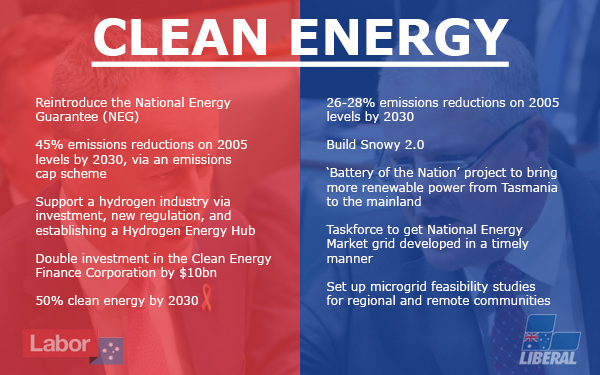No spin: The election renewable energy policies that will affect ASX stocks
News
As the major parties switch up the spin cycle ahead of the May 18 federal election, we’ve hunted the policies that will affect listed companies — so you don’t have to.
Renewable energy is, once again, front and centre of a federal election and the polls suggest this time it’s also become a much bigger issue for voters too.
There are also many ASX-listed companies that these policies will affect too, from grid-connected generators such as Genex (ASX:GNX) and Tilt Renewables (ASX:TLT), to off-grid companies like Tag Pacific (ASX:TAG) which have specialisations in areas such as microgrids.
These are the renewable policies of the two main parties that will, or may affect, ASX listed companies in this area.

Pitt Street Research founder Stuart Roberts, an avowed conservative, says the Liberal policy is better for the oil and gas sector (a sector Stockhead will cover in the coming weeks) at the expense of renewable energy.
This is because the current government policy is “to do as little as possible on energy” or maintaining “business as usual”.
He believes a Labor government will benefit renewables at the expense of the whole resources sector.
Labor plans to leverage the NEG to give companies the policy assurance to keep investing in renewable generation, and thereby also meet the party’s 50 per cent target.
They’ve said that if they can’t pass the NEG legislation, they want to direct the Clean Energy Finance Corporation (CEFC) to invest in renewable energy directly — which would be a negative for companies as they’d then need to compete with government-sponsored projects.
The extra generation capacity required to meet this will put huge pressure on the electricity grid. Labor says it’s countering this with a $5bn Energy Security and Modernisation Fund.
That will go to “future-proof” the grid by paying for upgrades to network interconnectors and new ones, as well as “facilitate investment” in new transmission lines which could see network operators such as AusNet (ASX:AST) given a hand to manage their networks.
Energy efficiency is still an industry in its infancy on and off the ASX. Mostly the listed companies include energy monitoring, such as BidEnergy (ASX:BID) and BuildingIQ (ASX:BIQ).
Labor wants to expand the remit of the Australian Renewable Energy Agency (ARENA), currently restricted to investing in projects that include renewable energy, to also look at ways to cut energy waste.
They’ll be relying heavily on the CEFC, which they’re giving an extra $10bn, as well as offering $20,000 grants to manufacturers for advice on energy management and improvement, such as data gathering and analysis, and data gathering.
Stockhead will break down Labor’s hydrogen policy in a following article on electric vehicles.
When it comes to the specifics of renewable energy, the Liberals are more circumspect and much was outlined in the Federal Budget earlier in April.
They plan to spend $3.2m on a taskforce to make sure the Australian Energy Market Operator’s (AEMO) projects to develop the National Energy Market (NEM) grid are completed in a timely manner.
These are part of AEMO’s Integrated System Plan, part of whose job it is to properly integrate intermittent power generation — renewables.
A $50.5m spend on microgrid feasibility studies for regional and remote communities could benefit a so-far little covered section of the energy market, including Tag Pacific (ASX:TAG), Renu Energy (ASX:RNE) and Pacific Energy (ASX:PEA).
The Liberals also plan to build Snowy 2.0, a plan that has some concerned, again, about the impact government-backed generators will have on the private sector.
They also have an energy efficiency policy, which will give businesses and community organisations grants worth $50m to launch energy efficiency projects and an extra $17m to help building owners monitor their energy use.
Finally, they’re supporting the construction of a second interconnector — effectively a power line — from Tasmania in order to turn the island into “the Battery of the Nation”.